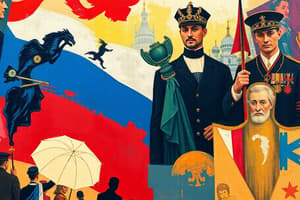Podcast
Questions and Answers
What was Tsar Alexander II's main reform attempt in Russia?
What was Tsar Alexander II's main reform attempt in Russia?
- Freeing the serfs (correct)
- Implementing industrialization policies
- Enforcing repressive measures
- Establishing a secret police force
Who emerged as a leader advocating for communism in Russia inspired by Karl Marx's ideology?
Who emerged as a leader advocating for communism in Russia inspired by Karl Marx's ideology?
- Tsar Nicholas II
- Vladimir Lenin (correct)
- Alexander III
- Sergei Witte
Which event marked the beginning of the 1905 Russian Revolution?
Which event marked the beginning of the 1905 Russian Revolution?
- Tsar Nicholas II's abdication
- Creation of the Duma
- Soldiers opening fire on civilians
- Father Gapon's peaceful protests (correct)
How did Tsar Nicholas II manage to survive the 1905 revolution?
How did Tsar Nicholas II manage to survive the 1905 revolution?
What was Sergei Witte's role in Russian history during this period?
What was Sergei Witte's role in Russian history during this period?
What was the main focus of Lenin's Bolshevik faction in Russia?
What was the main focus of Lenin's Bolshevik faction in Russia?
Flashcards are hidden until you start studying
Study Notes
- Video sponsored by NordVPN, featuring historical reenactment and humor.
- Character Jimmy travels through different European countries in the 1800s.
- Russia in the 19th century was feudal, underdeveloped, and ruled by Tsars.
- Tsars were focused on maintaining power, neglecting modernization, and causing a gap with Europe's progress.
- Tsar Alexander II attempted reforms like freeing the serfs but faced resistance and compromise.
- Alexander III followed with repressive measures to maintain control over ethnic minorities.
- Nicholas II, unprepared and timid, believed in his divine right to rule, leading to discontent among the people.
- Vladimir Lenin, a middle-class intellectual, emerged as a leader of the Bolshevik faction advocating for communism inspired by Karl Marx's ideology.- Mensheviks were concerned about Lenin's potential for dictatorship, but Lenin was focused on bringing communist utopia to Russia.
- Lenin, while in Europe, awaited an opportunity to overthrow the Tsar and establish communism.
- NordVPN is promoted for online security and access to restricted content.
- Sergei Witte pushed for industrialization in Russia, leading to poor working conditions and worker unrest.
- The 1905 Russian Revolution began with peaceful protests led by Father Gapon, which turned tragic when soldiers opened fire on civilians.
- Tsar Nicholas II survived the 1905 revolution through concessions like the creation of the Duma, but ultimately retained authoritarian power.
- Lenin, in exile, was disappointed with the failed revolution and believed armed revolution was the only way forward.
- Pyotr Stolypin implemented reforms and suppressions to prevent further revolution attempts, earning the nickname "Stolypin's Necktie" for his harsh measures.
- Lenin met Joseph Stalin, who was effective at fundraising for the Bolsheviks through questionable means.
- Rasputin's influence on the royal family and scandalous behavior added to the Tsar's declining reputation, despite economic improvements.
- The text ends with the imminent outbreak of World War I in 1914.
Studying That Suits You
Use AI to generate personalized quizzes and flashcards to suit your learning preferences.




